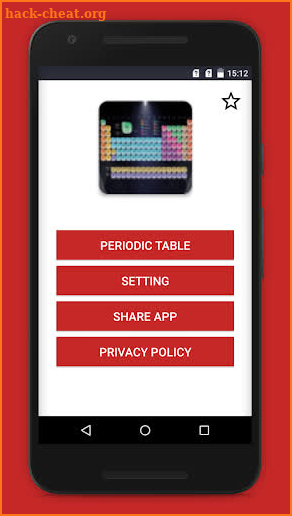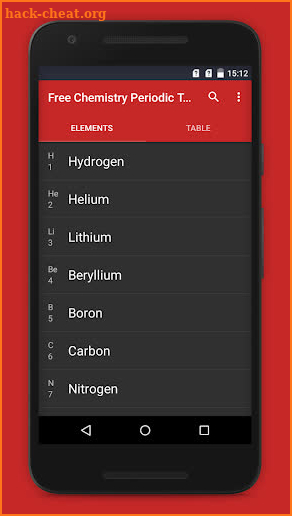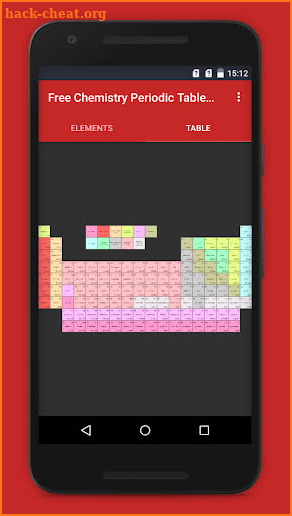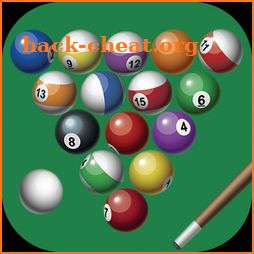

| For Android: 4.1 and up | Guide: Free Chemistry Periodic Table 2021 cheats tutorial |
| When updated: 2021-01-24 | Star Rating: 4.36 |
| Name: Free Chemistry Periodic Table 2021 hack for android | Extension: Apk |
| Author: Keyur Developers | File Name: com.keyurdevelopers.periodic |
| Current Version: 25.0 | User Rating: Everyone 10+ |
| Downloads: 100000-121976 | Version: mod, apk, unlock |
| System: Android | Type: Education |




Watch The Periodic Table of the Elements in Chemistry - [1-2-12] video.

Watch The Periodic Table Song (2018 Update!) | SCIENCE SONGS video.

Watch The 2021 Nobel Prize in Chemistry - Periodic Table of Videos video.

Watch GCSE Chemistry Development of the Periodic Table video.

Watch Periodic Table Explained: Introduction video.

Watch Periodic Table of Elements Explained - Metals, Nonmetals, Valence Electrons, Charges video.

Watch Modern Periodic Table video.

Watch The Periodic Table: Crash Course Chemistry #4 video.

Watch 9-1 GCSE Chemistry Paper 1 Atomic Structure and the Periodic Table video.

Watch Periodic Table - Atom 2021 (Chemistry App) video.

Gratis Chemistry Periodic Table 2021is a tabular arrangement of the chemical elements, ordered by their atomic number, electron configuration, and recurring chemical properties, whose structure shows periodic trends. Generally, within one row (period) the elements are metals to the left, and non-metals to the right, with the elements having related chemical behaviours placed in the same column. Table rows are commonly called periods and columns are called groups. Six groups have accepted names as well as assigned numbers: for example, group 17 elements are the halogens; and group 18 are the noble gases. Also displayed are four easy rectangular places or blocks associated with the filling of various atomic orbitals. The organization of the periodic table can be used to derive relationships between the different element properties, but also the predicted chemical properties and behaviours of undiscovered or newly synthesized elements. Russian chemist Dmitri Mendeleev was the first to publish a recognizable periodic table in 1869, developed mainly to illustrate periodic trends of the then-known elements. He also predicted some properties of unidentified elements that were expected to fill gaps within the table. Most of his forecasts proved to be correct. Mendeleev's idea has been slowly expanded and refined with the discovery or synthesis of further fresh elements and the development of fresh theoretical models to explain chemical behaviour. The modern periodic table now provides a useful framework for analyzing chemical reactions, and continues to be widely used in chemistry, nuclear physics and another sciences. All the elements from atomic numbers 1 (hydrogen) through 118 (oganesson) have been either discovered or synthesized, completing the first seven rows of the periodic table. The first 98 elements exist in nature, although some are found only in trace amounts and others were synthesized in laboratories before being found in nature. Atomic numbers for elements 99 to 118 have only been synthesized in laboratories or nuclear reactors. The synthesis of elements having higher atomic numbers is currently being pursued: these elements would start an eighth row, and theoretical work has been done to recommend possible candidates for this extension. Numerous synthetic radionuclides of naturally occurring elements have also been produced in laboratories. Each chemical element has a special atomic number (Z) representing the number of protons in its nucleus. Most elements have differing numbers of neutrons among various atoms, with these variants being referred to as isotopes. For example, carbon has three naturally occurring isotopes: all of its atoms have six protons and most have six neutrons as well, but about one per centhas seven neutrons, and a very little fraction have eight neutrons. Isotopes are never separated in the periodic table; they are always grouped together under a single element. Elements with no stable isotopes have the atomic masses of their most stable isotopes, where such masses are shown, listed in parentheses. Free Chemistry Periodic Table 2019 enables you to understand and find for all elements and you can also search their info in it. Feel Gratis to give suggestions. Thank You.



 VidPlayPro
VidPlayPro
 Jenny LeClue - Detectivu
Jenny LeClue - Detectivu
 4 COLOURS
4 COLOURS
 Cattywampus
Cattywampus
 Vital Word - Blood Pressure
Vital Word - Blood Pressure
 Alarm Clock - Wake Up Gently
Alarm Clock - Wake Up Gently
 Thai Farmer ปลูกผักแบบไทย
Thai Farmer ปลูกผักแบบไทย
 Photo Finish
Photo Finish
 777 Steam Slots: Mechanic
777 Steam Slots: Mechanic
 Đánh Bài Tiến Lên Đổi Thưởng
Đánh Bài Tiến Lên Đổi Thưởng
 Civil War: 1861 Hacks
Civil War: 1861 Hacks
 Ball Pool Hacks
Ball Pool Hacks
 Word Diamonds Hacks
Word Diamonds Hacks
 Indiana: Temple Escape Hacks
Indiana: Temple Escape Hacks
 Death Road 3 : Desperate Racing Hacks
Death Road 3 : Desperate Racing Hacks
 Christmas Drops 3 - Match three puzzle Hacks
Christmas Drops 3 - Match three puzzle Hacks
 Pink Piano Tiles: KPOP Hacks
Pink Piano Tiles: KPOP Hacks
 Solibus - a Sunlit Puzzle Hacks
Solibus - a Sunlit Puzzle Hacks
 Cute Tiger Rescue Best Escape Game-366 Hacks
Cute Tiger Rescue Best Escape Game-366 Hacks
Share you own hack tricks, advices and fixes. Write review for each tested game or app. Great mobility, fast server and no viruses. Each user like you can easily improve this page and make it more friendly for other visitors. Leave small help for rest of app' users. Go ahead and simply share funny tricks, rate stuff or just describe the way to get the advantage. Thanks!
Welcome on the best website for android users. If you love mobile apps and games, this is the best place for you. Discover cheat codes, hacks, tricks and tips for applications.
The largest android library
We share only legal and safe hints and tricks. There is no surveys, no payments and no download. Forget about scam, annoying offers or lockers. All is free & clean!
No hack tools or cheat engines
Reviews and Recent Comments:

Tags:
Free Chemistry Periodic Table 2021 cheats onlineHack Free Chemistry Periodic Table 2021
Cheat Free Chemistry Periodic Table 2021
Free Chemistry Periodic Table 2021 Hack download